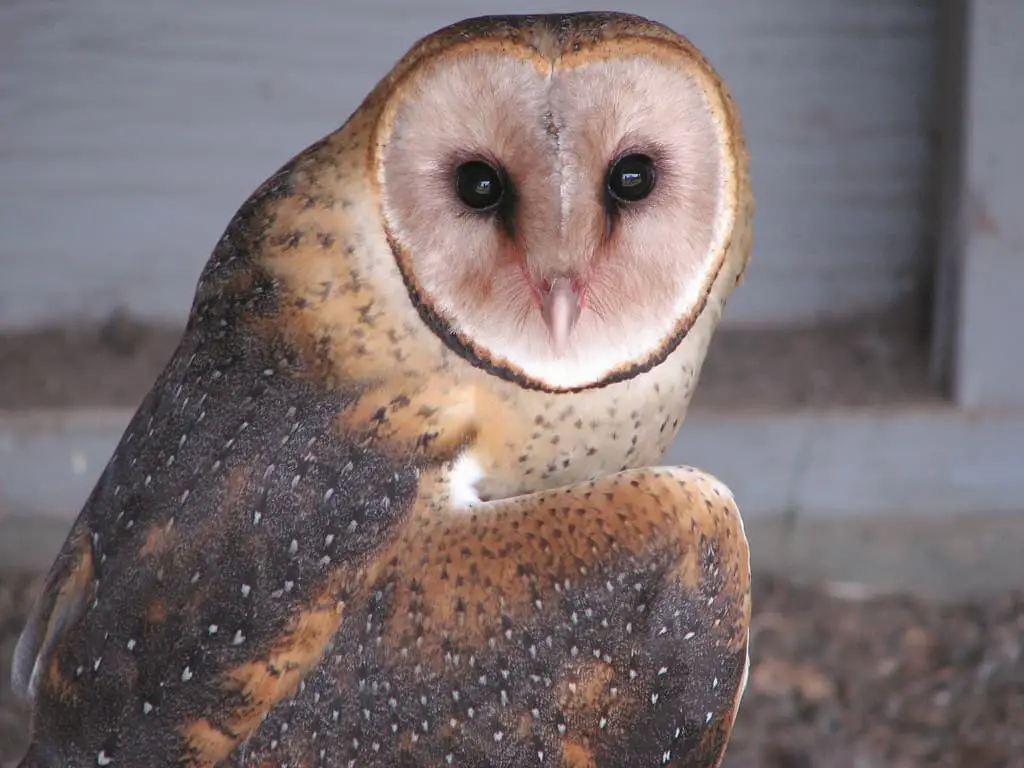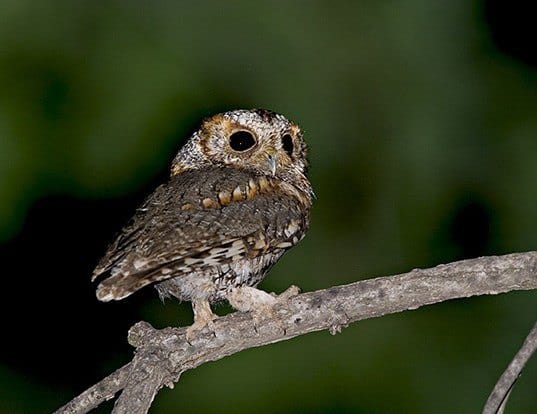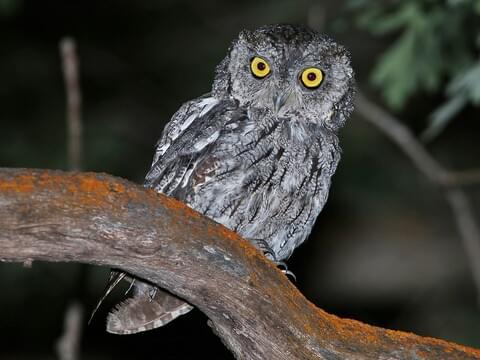Last Updated on: February 4, 2025
With their large heads and stocky bodies, owls are almost easily recognizable once you see them. If you dig deeper, however, you will know that there are different types, and hence, identifying one can be confusing.
Yes, it can be quite confusing.
There are more than 250 owls in the world, and you will find some of them in Arizona. Many of the species in The Grand Canyon State are present year-round, while others are migratory birds that visit only once it gets cold in the North.
Read on to find out about the owls in Arizona, including their physical characteristics and behaviors.
The Most Common Arizona Owls
1. Great Horned Owl

A powerful predator, the great horned owl is amongst the most common owls in North America, including Arizona.
With a length of up to two feet and a wingspan of up to five feet, it is the largest owl in The Grand Canyon State.
Aside from their large size, great horned owls are easy to identify because of the large feather tuffs you will find on their ears. Plus, they have sage yellow eyes.
Whether in the wild or the city, these owls are abundant. The most common habitats include parks, suburbs, deserts, swamps, and forests. They are adaptable, which allows them to thrive almost anywhere.
Great horned owls are known for being ferocious hunters. They can swallow their prey whole, which includes squirrels, rabbits, raccoons, falcons, and even other owl species. After digestion, they will litter the parts that they were unable to digest, including bone and fur.
Like most owls, they are nocturnal, which makes the great horned owls difficult to spot. In the dark, it is best to listen to their vocalizations to detect their presence. Females are often higher-pitched than males.
2. Barn Owl

It is almost impossible to miss these white owls in Arizona when you see them. The white and heart-shaped face without ear tufts gives it a distinct appearance.
Even at night, it is easy to spot barn owls in the wild. Not only that the colors make them stand out in the dark, but they also have a piercing cry, which is known to scare many night hikers.
The undulating flight pattern is another way for easy Arizona owl identification. Barn owls will glide low above the ground when looking for prey.
You will find their nests in hidden tree cavities. A barn owl will also nest in different types of man-made structures, such as church steeples, barn lofts, and houses.
They frequent lower altitudes and open countryside. Grasslands, open woodlands, and farmlands are some of their most common habitats.
Barn owls do not hoot. Instead, they have a piercing screech. They are silent most of the time, which is also what makes them efficient when hunting.
3. Short-Eared Owl

A common sighting in Arizona during the winter, these owls are open-country hunters. They are a favorite amongst many birdwatchers because they can be seen during the day, unlike most other owl species that are nocturnal.
Short eared owls have a recognizable round head with yellow eyes. As the name implies, it has small ears, which are almost invisible.
When hunting for food, these owls of Arizona can be seen flying low on the ground. They hover for a bit before they drop prey.
Its diet is mostly rodents, especially voles. Occasionally, it can also eat bats and muskrats.
If you want to see these birds, go to grasslands, airports, and open fields. While they fly during the day, your best time of spotting them is either at dawn or dusk.
4. Long-Eared Owl

As the name implies, their most recognizable physical characteristic is the long ear tufts, which are technically feathers. They point straight up, which looks like exclamation marks, especially when they are alarmed.
It is most common to see them in dense foliage, which is where they roost. The gray and brown mottling of. their body allows them to camouflage, making them challenging to spot in their natural habitats.
Listening to their vocalizations is an easy way to find long eared owls. They will make continuous low hoots with an interval of only a few seconds. They can also shriek, whine, and meow. The hoot of the males can be heard even at .7 miles away.
The sound-catching facial disks and the asymmetrical placement of ear openings give the long eared owls incredible hearing. They use such to hunt for food, which is mostly rodents. They will also eat small mammals, as well as other birds.
5. Flammulated Owl

These common owls in Phoenix are found throughout Central Arizona. They love the climate in the state, so it is easy to find them, especially in national forests.
For easy identification, look at its eyes, which are smaller than most Arizona owl species. To add, a flammulated owl has reddish-brown plumage that looks like tree bark.
Flammulated owls have unique vocal anatomy that differentiates them from the others. They have a hoarse and low-frequency call.
Even if it is a small owl, it has a large trachea. The size of the windpipe allows it to have a low-pitched hoot, which is comparable to what you can hear in larger birds.
They go about early at night or just before dawn to hunt. Their food is mostly insects, including beetles, moths, and crickets. They can also eat scorpions, spiders, and centipedes.
6. Western Screech Owl

Often confused with whiskered screech owls, western screech owls are amongst the smallest owls you will find in the state. They rarely go beyond ten inches in length, which also means that spotting them can be challenging.
A western screech owl is brown and gray with heavy streaks throughout its body. The ear tufts are small and pointy while the eyes are large and yellow. It can also be easily identified by its yellow bill and round body.
Their habitats are diverse. In rural settings, they are most common in evergreen and deciduous forests, scrublands, deserts, riparian areas, and lowland creeks. Meanwhile, western screech owls can also be found in urban locations, including city parks. They are most abundant in places with willows, oaks, and cottonwood trees.
Like most of the types of owls in Arizona, the diet is mostly insects. It will eat cicadas and scorpions, as well as other small birds. Hunting is done mostly at night, dusk, or dawn.
7. Whiskered Screech Owl

Belonging to the same family as western screech owls, whiskered screech owls have finely-patterned bodies with a combination of white, black, and gray.
Other physical characteristics that define western screech owls are their pointy but short ear tufts, round body, streaked plumage, and large eyes.
They have a limited range throughout the country. They are most abundant in the oakwood lands in Mexico but can also reach Southeast Arizona.
If you want to spot a whiskered screech owl in Arizona, the best thing to do is to visit sycamore groves in canyons. The best time to look for them is at dusk.
These small AZ owls are also known for being some of the most mysterious species, especially because they are not extensively researched since they have a small population.
When hunting for food, these small owls perch high and the ground and swoop down to catch their prey. It glides in the air as it searches for bats and insects.
8. Elf Owl

The name will already give you a clue of its appearance. It is one of the smallest owls on this list, with an average length of 4.9 to 5.6 inches.
While their sightings are rare, looking at pictures of owls in Arizona, you will see that aside from being tiny, they have a round head and do not have ear tufts. As for the color, brownish-gray feathers fill their bodies.
In Arizona, you can find these Sonoran desert owls in the spring and summer. Come winter, they will migrate to Mexico as they search for warmer environments.
They are listed as threatened owls in Arizona. Meanwhile, in California, elf owls are classified as endangered species.
Elf owls are insectivorous, hunting for food at night. Some of their most common targets are arachnids, crickets, moths, and beetles. Occasionally, they will also eat lizards.
9. Northern Pygmy Owl

One of the smallest owls you will find in California, it has an average length of 6.3 to 7.1 inches. These tiny owls have a long tail and large rounded head.
Above, they are brown with white spots. Below, the northern pygmy owl is white and has dark-brown streaks.
As it is common with pygmy owls, this bird has eyespots at the back. The latter is useful for deterring predators that can attack from its back.
When searching for northern pygmy owls, look for tree holes. They will often nest on spots that have been excavated by woodpeckers.
Your best chance to see them is in the wild. The best spots for bird watching are tropical forests, savannahs, open woodlands, and wetlands. They frequent areas near meadows and swamps. Unfortunately, you cannot attract these adorable owls to your backyard.
Similar to most of the widespread owls in the state, its diet is mainly insects, as well as rodents, lizards, and small birds.
10. Northern Saw Whet Owl

If you want to see owls native to Arizona, this is one that you should not miss. It is present almost throughout the year in the state.
This small owl can be difficult to recognize from afar because of its size. If you look closer, however, you will notice that it has a cat-like face with Y-shaped eyes. It has brown plumage with scattered brown spots and a vertical streak at the bottom.
For the best chances of seeing this tiny owl in Arizona, head to the northern and central parts of the state, specifically in areas with higher elevations. They are most common in the forest, especially during the winter. This is when the northern saw whet owls migrate south, so there is a higher chance that you will spot them during a bird-watching trip.
Known for being a strictly nocturnal predator, this Arizona owl will eat large insects and small mammals. During the day, it hides under dense canopies.
11. Burrowing Owl

With its large yellow eyes, thick brows, and streaked brown plumage, it is easy to identify this tiny owl.
On average, the burrowing owl length ranges from seven to 11 inches. Meanwhile, with its wings open, it spans approximately 20 to 24 inches.
Unlike most of the birds on this list, the burrowing owl spends the majority of its time on the ground and not perched on a tree or any other elevated spot.
Burrowing owls have a habit of making small depressions on the ground. It takes a dust bath by excavating the soil, which is also one of the most common ways to detect the presence of these owls that live in Arizona.
Listening to Arizona owl sounds is another effective way to find these birds. They create a hissing and rattling noise like rattlesnakes. Burrowing owls also mimic the strategy of the latter by burrowing on the ground, which is a part of its defensive tactics.
12. Mexican Spotted Owl

One of the three subspecies of spotted owls, the Mexican spotted owl is considered threatened. While you might find a small population in Arizona, the sightings are rare.
Aside from Arizona, the very few states where you will find this bird include Colorado, Texas, Utah, and New Mexico.
The destruction of their natural habitats is not the only factor affecting the decline in the global population. Another culprit is the increase in the population of barred owls, which are known for driving Mexican spotted owls away.
The length of Mexican spotted owls can range from 16 to 19 inches. Meanwhile, it can extend its wings at up to 45 inches, making it one of the largest Arizona owls.
It has a dark-brown plumage accented by white spots. The eyes are dark, which makes them haunting.
13. Ferruginous Pygmy Owl

Ferruginous means rust-colored, However, ferruginous pygmy owls can have varied colorations beyond rust, including gray-brown.
While the ferruginous pygmy owl lives in Arizona, it has a threatened status, so it is not commonly seen.
Despite being small, this Arizona owl has a stocky body. It has large feet, especially considering the size of its body.
More so, it has two black spots or false eyes at the back of its head/neck. These will help deter attacks from other birds, which is a part of its defense mechanism. When a bird is sneaking from behind, the ferruginous owl can still defend itself.
Those who want to include this owl in their next bird-watching itinerary should head to the southeastern part of Arizona.
Outside the state, you can also find them in southern Texas. Meanwhile, they are more abundant in Central and South America.
Watch This!
Frequently Asked Questions
What kind of owls live in Arizona?
Arizona is home to at least 13 different kinds of owls, including the following: great horned owl, barn owl, short-eared owl, long-eared owl, flammulated owl, western screech owl, whiskered screech owl, elf owl, northern pygmy owl, northern saw whet owl, burrowing owl, Mexican spotted owl, and ferruginous pygmy owl.
What do owls eat in Arizona?
Owls eat different foods, which can vary across species. In most cases, they will eat small rodents, including voles and mice. Squirrels, lizards, bats, rabbits, frogs, snakes, and other birds, also constitute its diet. Large insects are also common prey.
Are owls common in Arizona?
Owls are not common in Arizona. While you will find at least 13 species, including rare ones, they are not as rampant as other birds. More popular species include finches, doves, woodpeckers, sparrows, and hummingbirds.
What is the biggest owl in Arizona?
The great horned owl is the largest owl in The Grand Canyon State. It is a year-round resident that is also common in other parts of North America. On average, the length is up to two feet while its wings can span at a width of up to five feet. Meanwhile, the weight can range from 2.5 to four pounds.
Are owls protected in Arizona?
Yes, owls are protected in Arizona. One of the laws that protect raptors in the state is The Migratory Bird Treaty Act, which makes it unlawful to hunt, capture, kill, and possess certain wildlife, including burrowing owls.
Conclusion
With its varied geography and diverse wildlife, you will find several owls in Arizona. These owls consume rodents and pests, making them deliver ecologic and economic values.
Whether you are looking for owls in Tucson and other major cities, you will find a long list of species. At the same time, you will also see a wide variety of owls in Arizona Desert and other remote rural locations.
Are there others Arizona owls that you would like to add to this list? Leave a comment below and let us know!


I live in Surprise Arizona, extremely close to the White Tank Mountains.
We have a heavy population of the largest Great Horned owls.
I hear them many nights after dusk and into the night, even late into the AM late night hours.
I’ve even seen one on my house roof, which I believe was peering down at my cat, early one morning, just at sunrise..
It was a shocking sight and I actually feared for my cat.
Again, I hear them all night long, hooting and flapping, all night long.